Badke, a Belgian-Palestinian dance production, comes to New York Live Arts.
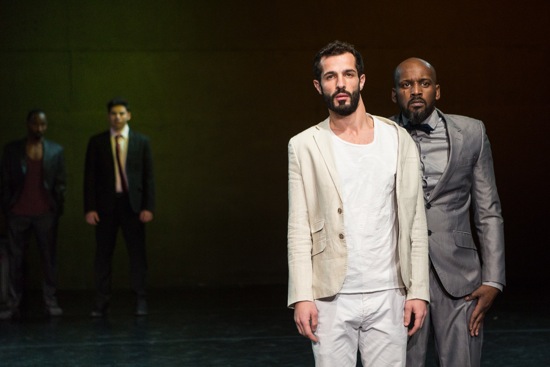
Badke. Maalii Maali (L) and Samer Samahnah; visible at back: Mohammed Samahnah (L) and Ameer Sabra. Photo: Yi-Chun Wu
There is no light in New York Live Arts’ theater, where Badke is beginning. In the darkness, we hear a shout, a strangled cry, a high ululation. Somewhere in front of us, feet are stamping. A rhythmic treading develops and builds into more complicated heard patterns. Then the lights come on, and we see them: ten people with their backs to us. They wear street clothes and shoes, some of the outfits dressier than others. Over the course of an hour or so, we will get to know these people— not intimately; they tell us no stories, but through the vital and regenerative power of their dancing.
The performance is part of NYLA’a 2016 Live Ideas Festival (February 8 to April 3): “MENA/Future: Cultural Transformations in the Middle East North Africa Region.” Badke is billed as “a Belgian-Palestinian dance production,” brought into being by KVS (the initials stand for the Flemish name of the Brussels-based Royal Flemish Theatre), les ballets C de la B (based in Ghent), and the A.M. Qattan Foundation in Ramallah.
There are more names to digest. The choreographer-directors of Badke are Koen Augustijnen, Rosalba Torres Guerrero (former dancers in C de la B), and dramaturge Hildegard De Vuyst (who inspired and coordinated PASS, the KVS’s Palestine Project). The music by Naser Al-Fares (you can hear him sing on youtube) has been edited by Sam Serruys, so it is traditional, yet not entirely so. Four of Badke’s original dancers are credited with contributing to the choreography, yet so suited is it to the current dancers’ personal skills and so often spontaneous looking that you can imagine they are occasionally improvising.
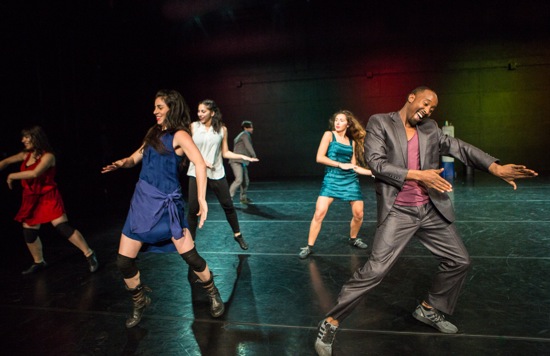
Badke‘s dancers. (L to R): Salma Ataya, Samaa Wakeem, Aseel Qupti, Fadi Zmorrod, Hiba Harhash, Mohammed Samahnah. Photo: Yi-Chun Wu
Badke refers to a culturally and socially complex history. The title is a play on “dabke,” an Arabic dance with deep folkloric roots and numerous variants, and these Palestinian performers, with their very diverse backgrounds, draw on many other sources. Salma Ataya began as a dabke dancer. Ameer Sabra is an expert at hip-hop and breakdance, as is Samer Samahnah. Hiba Harharsh pursued a postgraduate degree in dance studies in London. Ayman Safiah studied ballet and contemporary dance there. Mohammed Samahnah says he’s self-taught. Fadi Zmorrod co-founded the Palestinian Cirkus School. Maali Maali started a dance group in Ramallah that specializes in acrobatic dance influenced by martial arts. Samaa Wakeem, a Palestinian resident of Israel, studied ballet and contemporary dance in a kibbutz. Aseel Qupti trained in those disciplines in Nazareth. (This, of course, doesn’t tell of all the groups they joined or founded or the universities they may have studied at.) I learned later that three of them were making their debuts in Badke at NYLA.
This dance demands that they become a community. They join one another’s patterns. Explode from them. They seek out partners. They collaborate on a task. They comfort others and are suspicious of them. The dabke is the unifying force. Many times they form a circle or a chain to perform its basic steps (cross one foot over the other, step; repeat; kick out one foot; lift a knee; stamp; repeat all— and choreographic variants that can amplify it). Their ferocious intensity and their wild joy transcend whatever difficulties they (and/or their onstage personas) may face in their day-to-day lives.
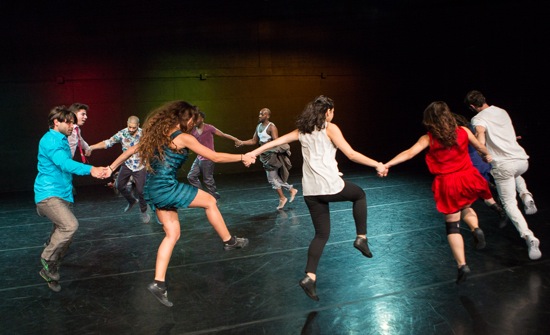
Clockwise from right: Maali Maali, Salma Alaya, Aseel Qupti, Hiba Harhash, Fodi Zmorrod, Ameer Sabra, Ayman Safiah, Mohammed Samahnah, Samer Samahnah. Photo: Yi-Chun Wu
The pretext may be a wedding. Ataya and Zmorrod often seek each other out during the festivities. It is Qupti, however, who looks shy (or ashamed) in a brief scene with Harhash, who dances encouragingly—even perhaps scoldingly—around her. And Qupti is the one the men hold high in a standing position, then let fall back into their arms so they can toss her into the air. After this, she’s smiling. But no matter what occurs, the dabke brings them together again; two or three start it, others feed in.
Lord, how they dance! And in how many ways. Harhash’s opening solo brings to mind the seductive aspect of some Middle Eastern dances, her body and arms rippling, her gaze toward us emphasizing the sensuality of the movements. Yet some of the fluid body language in Badke comes from hip-hop. At times, both men and women wriggle their hips, snake their arms, and work their shoulders; in a momentary duet, Maali and S. Samahnah confront us, close together, swiveling their necks while holding their heads steady. M. Samahnah takes off running and erupts into a sky-bound leap or two. He, Maali, and/or Zmorrod may at any point turn back flips. Given a moment alone in the rejoicing melee, Safiah executes a beautifully placed pirouette à la seconde and finishes beating his feet together in the air.
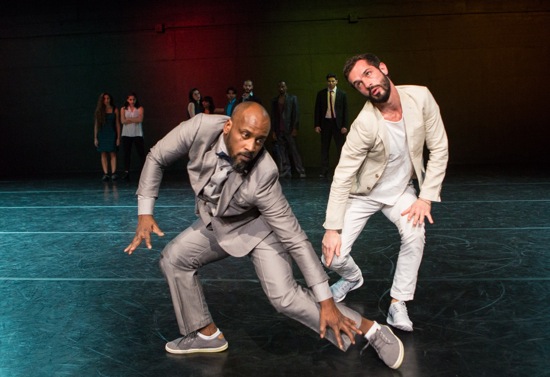
Samer Samahnah (L) and Maali Maali in Badke by Koen Augustijnen, Rosalba Torres Guerrero, and Hildegard De Vuyst. Photo: Yi-Chun Wu
The only décor is a water cooler, to which the dancers frequently resort. There’s also a chair on which someone can take a rest. Small red “aprons” are available for them to tie on in any way they like for one part of the ritual and then toss offstage. And the clothes the men discard pile up; off come the jackets, the shirts. Sabra loosens his necktie.
The choreographers want to remind us that life for Palestinians in their native cities can be fraught (for example, dancer Lina Khattab, the 18-year-old sister of one of the original creators of Badke, was released last June from a six-month prison sentence under harsh conditions for participating in a demonstration). Badke tells no political tales, but it hints at problems. Without warning, the lights go out and the music stops. Another power failure? Or? “You okay?” someone asks. There’s very little movement and almost no sound in the dimly lit space. Small groups gather and whisper; someone whistles; someone else says “shh!” But whistling turns out to be a restorative. Pretty soon they’re whistling in rhythm; pretty soon they’re dancing in time to it. After a while, the lights and the music return, and the rowdy celebration just keeps going.
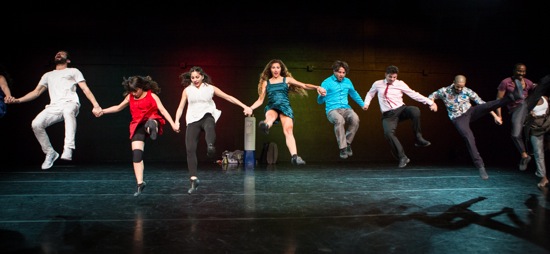
The transformed dabke in Badke. Visible L to R: Maali Maali, Salma Ataya, Aseel Qupti, Hiba Harhash, Fadi Zmorrod, Ameer Sabra, Ayman Safiah, and Mohammed Samanhah. Photo: Yi-Chun Wu
Other moments are graver. Sometimes the music becomes ominous or ugly in some way (low thuds, a howling noise). Sometimes the only sounds are those the dancers make Several times, they look toward us, holding their hands up, palms front, as if warding off danger or surrendering, backing away from some line they’re not to cross.
I hesitate to interpret some of the references. I heard that Harhash “shooting” the others, then herself, may be a game. I don’t know why Sabra at one point is crouched, cringing and pushing at the air, nor, on a brighter note, do I understand why S. Samahnah wraps a heavy skirt around himself and dances happily wearing that for a while. When a man pinches his own butt, or two guys walking along pinch each other’s butts, I postpone interpretation. A vignette or two bring animals to mind; S. Samahnah hovers over Maali’s prone body, scanning and nuzzling it like a creature with its prey.
The astonishing performers exhaust themselves in this dance, both virtually and actually. As if the joy that the occasion engenders has to be constantly recharged, and stopping means coming down from a high. In the end, they’re again warding away something that comes from our direction; then gradually they turn their palms away and begin to curl them in. Still backing away, they send another message. With some trepidation, they invite us: “come!”
